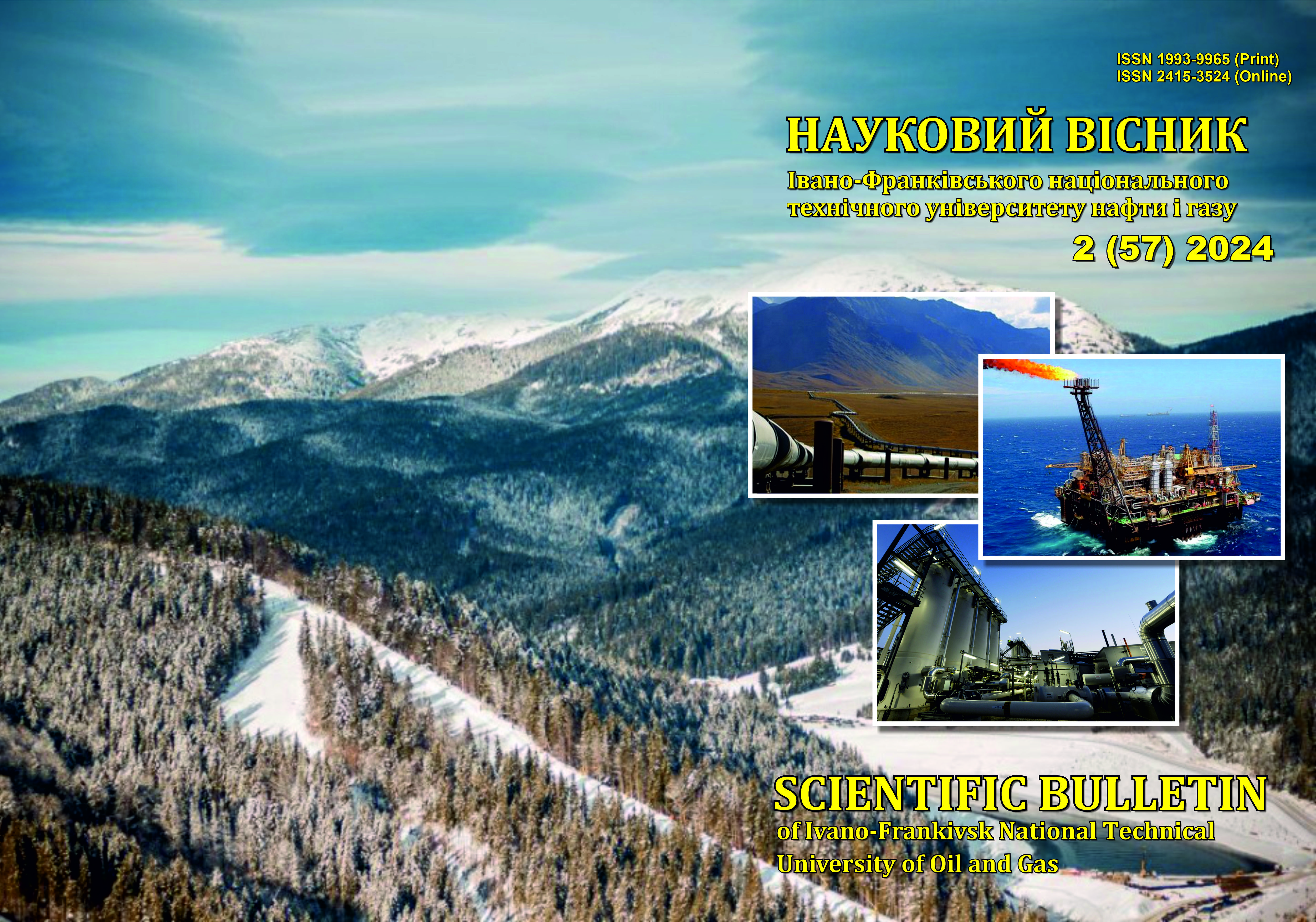DEVELOPMENT OF NEW REINFORCING PHASES OF THE MO2FE1-XCRXB2 SYSTEM FOR STRENGTHENING THE WORKING SURFACES OF OIL AND GAS EQUIPMENT
DOI:
https://doi.org/10.31471/1993-9965-2024-2(57)-7-14Keywords:
wear resistance, refractory borides, hardness, fracture toughness, substitutional solid solutions, first-principles calculations.Abstract
Ensuring the durability of working surfaces in oil and gas equipment operating under abrasive wear conditions requires the use of new materials that combine high hardness and fracture toughness. This combination of properties is most pronounced in refractory compounds of transition metals, particularly borides. In this work, first-principles calculations within the framework of density functional theory (DFT) were performed to study the properties of complex borides with the formula Mo₂Fe₁₋ₓCrₓB₂. To model solid solutions, the virtual crystal approximation approach was applied, where the solid solution model was achieved by "mixing" the pseudo-potentials of the components. As a result, the elastic moduli, hardness, fracture toughness, and Debye temperature were determined. Additionally, an evaluation of the electronic structure characteristics of the solid solutions was carried out by determining the density of electronic states and the electron localization function. The analysis of the obtained data shows that in the Mo₂FeB₂ – Mo₂CrB₂ system, a series of continuous solid solutions is formed, which are characterized by nonlinear changes in lattice parameters and the corresponding degree of tetragonality. Meanwhile, the Young’s and shear moduli of the Mo₂Fe₁₋ₓCrₓB₂ solid solutions decrease in the range of 0<x<0.4 and increase in the range of 0.4<x<0.9, while the bulk modulus remains at around ~300 GPa. The concentration dependence of hardness, calculated using an averaged model, also changes nonlinearly, with a minimum hardness (~14 GPa) observed for the solution Mo₂Fe₀.₆Cr₀.₄B₂ and a maximum (~26 GPa) for the solution Mo₂Fe₀.₁Cr₀.₉B₂. It should be noted that for solutions with hardness above 20 GPa, the calculated fracture toughness exceeds 3.8 MPa•m¹/², while for solutions with lower hardness, fracture toughness is also low. Based on a comparative analysis, it was established that the most optimal combination of properties is exhibited by the solution Mo₂Fe₀.₁Cr₀.₉B₂. The analysis of the electronic structure revealed that the high level of properties is provided by a reduction in the contribution of antibonding states above the Fermi level and, simultaneously, an increase in the contribution of pd-hybridized orbitals formed in metal-boron pairs.
Downloads
References
Tang L., Wang P., Ma Z., Pauliuk S., Chen W.-Q., Dai T., Lin Z.. Exploring the global trade networks of the tungsten supply chain: Insights into the physical and monetary mismatch among countries. Journal of Industrial Ecology. 2023. Vol. 27. No 1. P. 323–335. https://doi.org/10.1111/jiec.13333
Shlapak L., Shihab T., Prysyazhnyuk P., Yaremiy I. Structure formation of the chromium carbide-based cermet with copper-nickel-manganese binder. Metallofizika i Noveishie Tekhnologii. 2016. Vol. 38. No 7. P. 969–980.
Coronado J. J. Effect of (Fe,Cr)7C3 carbide orientation on abrasion wear resistance and fracture toughness. Wear. 2011. Vol. 270. No (3–4). P. 287–293. https://doi.org/10.1016/j.wear.2010.10.070
Prysyazhnyuk P., Di Tommaso D. The thermodynamic and mechanical properties of Earth-abundant metal ternary boride Mo2(Fe,Mn)B2 solid solutions for impact-and wear-resistant alloys. Materials Advances. 2023. Vol. 4. No 17. P. 3822–3838. https://doi.org/10.1039/d3ma00313b
Li B., Zheng Y., Wang W., Wu H., Li Y., Lv J.. Strengthening mechanism of Cr doping in Mo2FeB2-based cermets and effects on biphase interface. International Journal of Refractory Metals and Hard Materials. 2024. Vol. 118. Art. No 106485. https://doi.org/10.1016/j.ijrmhm.2023.106485
Cao Z., Jian Y., Zhao Z., Xiao P., Xu L., Huang Z. On the dissolution and enhancement mechanisms of Cr doping in Mo2FeB2-based cermets. Ceramics International. 2023. Vol. 49. No 4. P. 6139–6148. https://doi.org/10.1016/j.ceramint.2022.11.007
Shen Y., Huang Z., Xiao P., Zhang L., Li K., Cao Z., Jian, Y. Sintering mechanism, micro-structure evolution and nanomechanical properties of Cr-added Mo2FeB2 based cermets. Ceramics International. 2020. Vol. 46. No 10. Part A. P. 15482–15491. https://doi.org/10.1016/j.ceramint.2020.03.093
Shi Z., Yin H., Xu Z., Zhang T., Yang G., Zheng Q., Rao R. S., Yang J., Gao F., Wu M. Microscopic theory of hardness and optimized hardness model of MX1B and M2X2B2 (M= W, Mo; X1= Fe, Co, X2= Fe, Co, Ni) transition-metal ternary borides by the first-principles calculations and experimental verification. Intermetallics. 2019. Vol. 114. Art. No 106573.
Bembenek M., Prysyazhnyuk P., Shihab T., Machnik R., Ivanov O., Ropyak L. Micro-structure and Wear Characterization of the Fe-Mo-B-C—Based Hardfacing Alloys Deposited by Flux-Cored Arc Welding. Materials. 2022. Vol. 15. Iss. 14. Art. No 5074. https://doi.org/10.3390/ma15145074
Hafner J. Kresse G.. The Vienna AB-Initio Simulation Program VASP: An Efficient and Versatile Tool for Studying the Structural, Dynamic, and Electronic Properties of Materials. In Properties of Complex Inorganic Solids (pp. 69–82). Springer US. https://doi.org/10.1007/978-1-4615-5943-6_10
Wang V., Xu N., Liu J.-C., Tang G., Geng, W.-T. VASPKIT: A user-friendly interface facilitating high-throughput computing and analysis using VASP code. Computer Physics Communications. 2021. Vol. 267, Art. No 108033. https://doi.org/10.1016/j.cpc.2021.108033
Bellaiche L., Vanderbilt D. Virtual crystal approximation revisited: Application to dielectric and piezoelectric properties of perovskites. Physical Review B. 2000. Vol. 61, No 12. P. 7877–7882. https://doi.org/10.1103/physrevb.61.7877
Perdew J. P., Burke K., Ernzerhof, M. Generalized gradient approximation made simple. Phys. Rev. Lett. 1996. Vol. 77. No 18. P. 3865–3868. https://doi.org/10.1103/PhysRevLett.77.3865
Perdew J. P., Chevary J., Vosko S., Jackson K. A., Pederson M. R., Singh D., Fiolhais C. Erratum: Atoms, molecules, solids, and surfaces: Applications of the generalized gradient approximation for exchange and correlation. Physical Review B. 1993. Vol. 48. No7. 4978.
Monkhorst H. J., Pack, J. D. Special points for Brillouin-zone integrations. Physical Review B. 1976. Vol. 13. No 12. Art. No 5188.
Hill R. The elastic behaviour of a crystalline aggregate. Proceedings of the Physical Society A. 1952. Vol. 65. No 5. Р. 349–354. https://doi.org/10.1088/0370-1298/65/5/307
Chen X.-Q., Niu H., Li D., Li Y. Modeling hardness of polycrystalline materials and bulk metallic glasses. Intermetallics. 2011. Vol. 19. No 9. P. 1275–1281. https://doi.org/10.1016/j.intermet.2011.03.026
Mazhnik E., Oganov A. R. A model of hardness and fracture toughness of solids. Journal of Applied Physics. 2019. Vol. 126. No 12. Art. No 125109. https://doi.org/10.1063/1.5113622
Miao N., Sa B., Zhou J., Sun Z. Theore-tical investigation on the transition-metal borides with Ta3B4-type structure: A class of hard and refractory materials. Computational Materials Science. 2011. Vol. 50. No 4. P. 1559–1566. https://doi.org/10.1016/j.commatsci.2010.12.015
Teter, D. M. Computational alchemy: The search for new superhard materials. MRS Bulletin. 1998. Vol. 23, No 1, P. 22–27.
Tian Y., Xu B., Zhao Z. Microscopic theory of hardness and design of novel superhard crystals. International Journal of Refractory Metals and Hard Materials. 2012. Vol. 33. P. 93–106. https://doi.org/10.1016/j.ijrmhm.2012.02.021
Pugh S. F. XCII. Relations between the elastic moduli and the plastic properties of polycrystalline pure metals. The London, Edin-burgh, and Dublin Philosophical Magazine and Journal of Science. 1954. Vol. 45. No 367. P. 823–843. https://doi.org/10.1080/14786440808520496
Grimvall G., Sjödin, S. Correlation of properties of materials to Debye and melting temperatures. Physica Scripta. 1974. Vol. 10. No 6. P. 340–352. https://doi.org/10.1088/0031-8949/10/6/011
Downloads
Published
How to Cite
Issue
Section
License
Авторські права....


1.png)

















